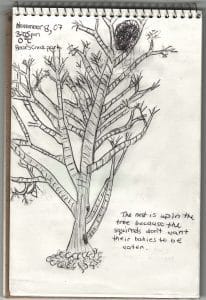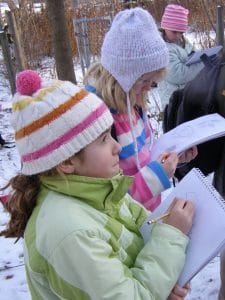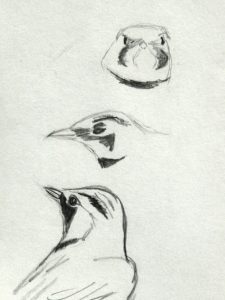Nature is replete with beautiful vistas, vibrant colors, intriguing species, poetic moments and always the unexpected. It is wonderful to be able to capture some of these discoveries on paper and to reflect more deeply on the experience. Journaling is an activity that can help everyone – regardless of age – retain memories and impressions of nature for years to come.
Nature journaling is simply the act of using words and sketches to record observations, feelings and thoughts about an aspect of nature that has caught your attention. It provides a wonderful opportunity to relax and spend time alone or with friends and family. The nature journal soon becomes a much-loved companion to all of your outings. Because the act of drawing requires focus, you end up seeing so much more. This is especially so for details such as colour, shape, texture and interesting behaviours. In this way, you remember an experience or sighting in greater detail than by simply taking a photograph. Even years later, clear memories of a special moment in nature come flooding back as you leaf through the pages of your journal.
Rather than drawing as an artist, it is less intimidating to think of yourself as a scribe or reporter. This is not an art exercise, but something done for enjoyment. Think of a nature journal as a treasure hunt. You may wish to make detailed descriptions of your observations, or simple, point-form notes scattered around a drawing. Your notes can include questions about what you are observing, philosophical ramblings, personal reflections and favorite quotes or lines of poetry.
You don’t even have to be outside. You can record the observations you make from a window or draw items collected on a walk (e.g., a variety of leaves) after you get home. You might also want to take some photographs and glue them in your journal as well.
Some basics
A small, hard-covered sketchbook with unlined paper works best. Buy a few 2B pencils (softer graphite for plants and birds) although any pen or regular pencil will do. You should also have some good quality coloured pencils and/or watercolour pencils, a small pocketknife for sharpening purposes and an eraser.
Include the date, time (clock time or “early afternoon”), location, weather, approximate temperature and any other environmental conditions of note (e.g., birds singing, a certain smell in the air). Take no more than five to ten minutes for most drawings. Use point-form notes and arrows to briefly describe what you draw. Include any species names, if you know them. You might also want to include a measurement if it’s important for identification purposes. Know your thumb and forearm lengths for reference.
Try to draw a mixture of ground observations such as things you can draw life size (e.g., a maple key), eye-level observations (e.g., entire plants or trees), things happening overhead (e.g., a soaring bird, clouds), and whole landscapes. The possibilities of what to draw are endless. To get started, focus on the commonplace and the near-by. You might also want to choose subjects that change over the course of the year. This can be as simple as a tree in your backyard or a distant vista. Nature journaling is a wonderful way to really get to know the place you live and the creatures that inhabit that space through the seasons.
Working with kids
Nature journaling can be a wonderful way to help children develop a personal relationship with the natural world. It is also a great intergenerational activity when parents, grandparents or teachers do journaling with family members or students. When you are working with children, however, there are a some things to keep in mind: 1. As a rule, encourage the children to do quick, diagrammatic drawings, also known as line drawings. Have them add written notes of the object’s size, colour, interesting characteristics and name if known. 2. Try to limit the time devoted to each drawing and descriptions to no more than ten minutes. 3. Remind the children that they are not doing “art” and do not need to feel inadequate if their drawings are less than realistic. Extra details can always be added when they get home. 4. Before moving on to the next location or subject, you and the children should take a moment to share your drawings and to point out what caught your attention. 5. Over time, you may wish to teach the children some drawing techniques such as perspective, shading and how to capture basic shapes. 6. Return to the same location regularly to increase a sense of belonging to a natural environment and foster awareness of the subtleties of seasonal change. 7. Encourage the children to draw from lying down, sitting and standing. 8. Ask them to record how they feel about what they are observing. 9. You might also challenge the children to have a special place in their journal for their own poetry or personal thoughts about the natural world. 10. Most importantly, let them see you journaling, too!
Seasonal ideas
FALL– Flocks of birds including geese or gulls overhead, starlings on wires, squirrels in different locations and showing different behaviours, late-blooming flowers, leaves of different colours and shapes, trees of different colours and shapes, a variety of seeds and berries, the seed heads of grasses, fungi and lichens, woodpecker holes in a tree, a landscape showing colourful trees on distant hills, different cloud types, sunrise and/or sunset drawn from exactly the same location as the season progresses (the sun’s position on the horizon will change as the months go by), nature-based decorations associated with the harvest, Thanksgiving and Halloween
WINTER: Abandoned nests in trees, a page of the different bird species at the feeder, tracks in the mud or snow, squirrel antics at the feeder, silhouettes of winter deciduous and coniferous trees, twigs and buds, the needles of different conifers, leaves still clinging to twigs, goldenrod galls, dead flowers in a garden or field, snowflakes, icicles, frost on a window, long winter shadows, moon phases, constellations, the same landscape as in the fall, sunrise and/or sunset from the same location, nature-based decorations associated with Christmas
SPRING: Return of migrants (e.g., robin in snow), activities of nesting birds, a singing bird accompanied by a representation of its song, earthworms on the sidewalk, the frog chorus coming from a wetland (small bells could represent a spring peeper’s song), the first flowers in the garden or on a tree, the emergence of a single leaf (drawn from one day to the next), changes in a tree over the spring, rain storms & puddles, the same landscape as in the fall and winter as leaves begin to emerge, sunrise and/or sunset from the same location, a visit to a sugar bush, Earth Day activities
SUMMER: Hummingbirds at a feeder, birds taking a bath, robins in different locations and showing different behaviours, a selection of birds in flight, close-ups of insects, garden flowers, roadside flowers, leaves of different shapes and vein patterns, aquatic plants, document and illustrate the weather for a week, the same landscape as in the other seasons, sunrise and/or sunset from the same location, nature sightings during a family vacation


